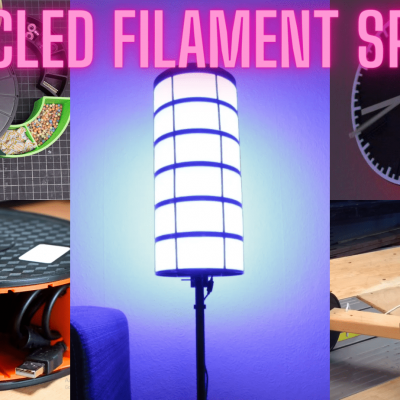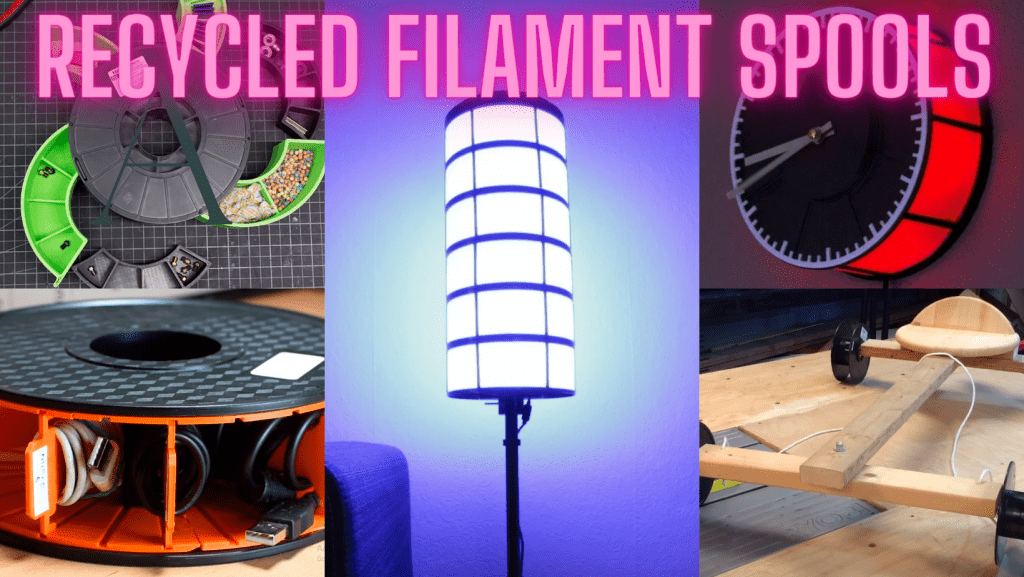
Filament is the fuel of an FDM 3D printer, but once you run out, you’re left with an empty. Most people will just throw away the spools, but you don’t have to. Instead of adding to your plastic footprint, you can reuse the spool in new ways that benefit you.
There are tons of different ways people have repurposed empty spools, from a drawer organizer to a cable reel. People even use them on little karts for their kids and other toys!
Want to hear more ideas for what to do with old filament spools? Just keep reading!
Table of Contents
Can Filament Spools Be Recycled?
Yes, empty filament spools can, in fact, be recycled. But to what degree you can recycle empty spools depends on the specific spool.
Most spools are made out of injection-molded ABS plastic, which is considered an environmentally-harsh material because it’s made from crude oil. While ABS can be recycled, most recycling providers (varies by state in the U.S.) don’t accept ABS in the traditional recycling bins.
If you want to make sure your ABS-made empty spool doesn’t end up in a landfill, the safest bet would be to go to your local recycling center and hand it to them. What I usually do is wait until I have 5-10 spools and then go because making that trip for each empty spool is pretty time-consuming.
But not all spools are made of ABS. Some are made of polypropylene (PP), which is a recyclable plastic that can be thrown in any traditional recycling bin.
Another spool material, which is increasingly popular among manufacturers for its environmental friendliness, is cardboard. Cardboard is perhaps the most recyclable material of the three, and you can put these types of empty spools in any recycling bin.
What To Do With Old Filament Spools? Here Are Our Top Ideas:
But what’s better than just throwing your old spool in the recycling bin is repurposing it. That way, you produce less potential waste (especially for ABS plastic spools), and you get something in return. The 3D printing community has come up with many different things to do with old spools, and I’ve listed some of my favorites below:
Drawer Organizer
First up, we have a drawer organizer. These require some 3D printed drawer sections, which are inserted into the gap in the spool, making for a very ergonomic and efficient storage solution. You can use the space to organize things, like pens, coins, or even your spare nozzles or 3D printer tools.
I’ve listed some popular 3D printed drawer options below:
Wall Clock
Need to tell the time? A wall clock is another fun way to repurpose your old filament spool. With some LEDs, a handful of 3D printed parts, and a motor, you can follow this guide to make your own clock like the one seen in the image above.
Turnable Paint Holder
Another way you can use your empty filament spool to organize your stuff is by turning it into a rotatable paint holder. One project I found uses 3D printed fittings that go into the gap in your spool and hold different small paint bottles. Another project uses a spool like a Ferris wheel to hold larger paint bottles.
Cable Reel
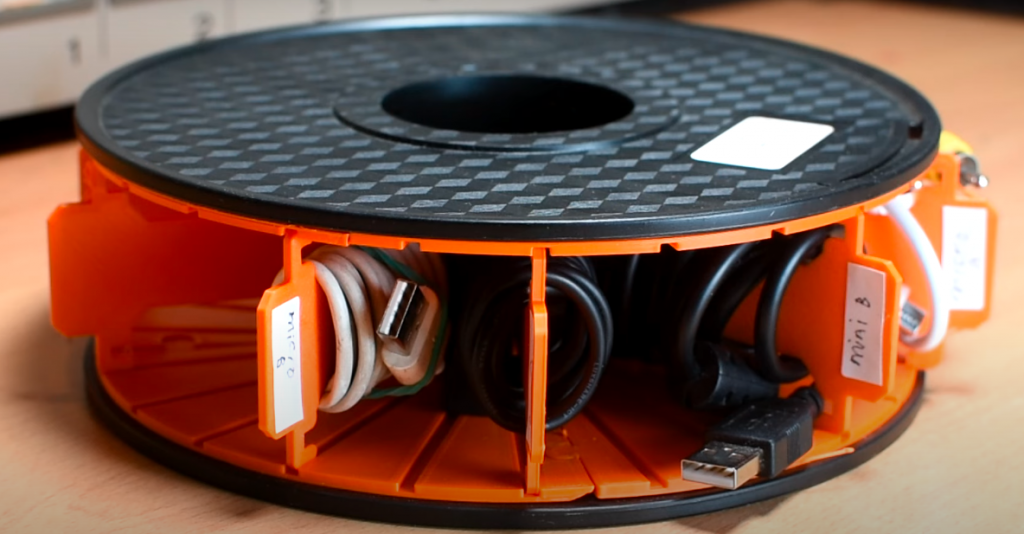
A cable reel is an obvious solution for repurposing your old filament spool because cable spools already look a lot like empty filament spools. All you need to do is find a rope, cable, or wire that’s pretty long and wrap it around the inside of the filament spool. Just make sure you tie it off at the beginning and the end, so it doesn’t fall off.
Wheels for Kart & Toys
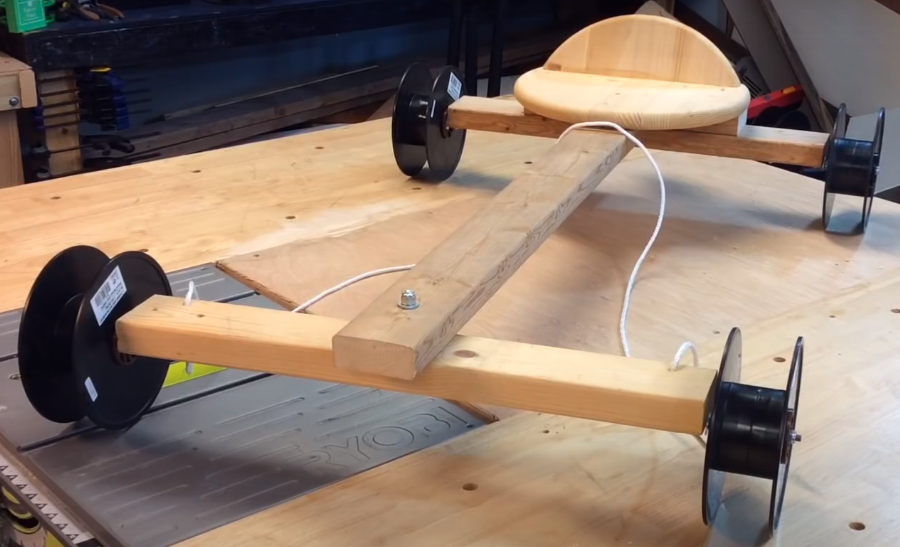
As filament spools are very precisely circular, they make for the perfect wheel for karts or other toys that need wheels. Surprisingly, empty filament spools can handle a good bit of weight as wheels on a little kart, and you can even add steering to them.
Lamp
If you’re looking for a good way to decorate your living space, then I’ve got an amazing solution for you: a lamp made out of empty filament spools. There are a handful of online projects, such as this single-spool option and this multi-spool option, that go over exactly how to turn a few filament spools into an actually visually appealing (and eco-friendly) lamp. You just need a few 3D prints, some LED lights, and a couple of screws.
Yarn Winder
Similar to the cable reel, you can wrap yarn around your empty spools. But if you want to take it a step further, you can 3D print the files found in this project to make a hand crank for the spool so that you can more rapidly wrap or unravel yarn from the spool. It also works for loose rope!
How to Recycle Filament Spools into New Filament?
Another great idea for repurposing your empty filament spools is to turn it into actual filament. Yep! You can literally take your empty spools, grind and melt them, and make your own filament. We’ve gone over the general steps below:
Know your Plastic
The first step is to know the plastic of the spool. As you might expect, this process won’t work on cardboard spools, but ABS, ABS blends, and even polypropylene spools should work fine. You can usually find the specific plastic that you’re empty spool is made out of on the spool or by asking the manufacturer (they typically tell you!).
Cut Spools in Half
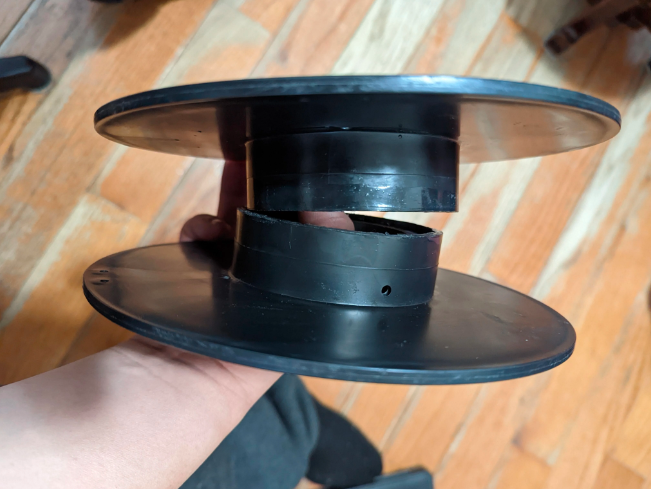
The first real step is to cut your spool, or spools, in half, by the core of the filament (where the spool holder goes). You can do this manually using a hacksaw. But I prefer using my Dremel or a bandsaw as I sweat a lot less.
You can also choose to cut it more times, like into fourths or eighths. The smaller it is now, the faster the process will be later!
Grinding
Now it’s time to grind the filament spool into small pellets. For this step, you’ll want a plastic grinder. I don’t expect you have one of these just lying around, but maybe your friend or local hardware store does. You can also buy one that’s meant for turning plastic back into filament!
Load the chopped-up filament spool parts into the funnel of the grinder, and turn it on. It will take a little bit for the spool to get fully shredded up, but just give it time. Once its done, put the shredded plastic bits (which should be pretty fine and small) into a container.
Filament Extruding
Now, for this step, you’ll need a filament extruder, which is a device meant to turn tiny plastic bits into 3D printable filaments through a complex melting and cooling process. Like with the grinder, see if anyone or place you know has one before buying one because they can get expensive. You can also build one if that’s more your speed.
Once you’ve got one, though, load the grinded-up plastic bits into the hopper of the
extruder device and turn the device on. Make sure to set the extruder settings to match your desired filament diameter (that’s 1.75 mm for most people).
You’ll also want to wrap the extruded filament around a spool so that it’s not just one big long stretch. A spooling device helps with this, but you can also do this process by hand if you’ve got time.
3D Print Test Models
Now that you’ve got your filament, it’s time to start 3D printing it! It’s unlikely that you’ll get perfect prints on the first try, so start by 3D printing test models and properly tuning your slicer settings after each one to improve the print quality. I’d recommend starting out with a temperature tower model so you can know what hot end temperature to use.
And, once you’ve perfected your slicer settings, that’s it! You’ve successfully completed the cycle, turning your filament spool into actual, usable filament. Congratulations!
Conclusion
Filament spools may seem like a necessary waste associated with 3D printing, but you don’t have to throw them out. First, if you don’t want to hold on to the spool, you can try recycling it, even if it’s made out of ABS.
You can also repurpose the spool to make things like a desk organizer, a cable reel, a yarn winder, a functioning clock, or even a decorative and sexy lamp. And, if you’ve got the time and resources, maybe you want to try turning the filament spool into usable filament!
But whatever you do, don’t just throw it away!
Related Articles:


